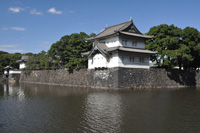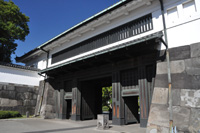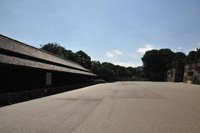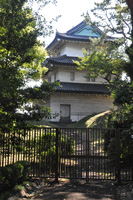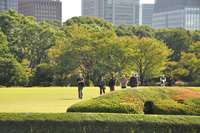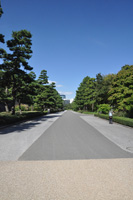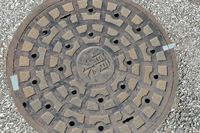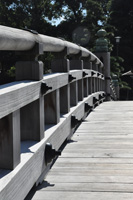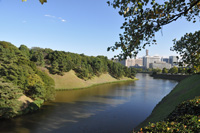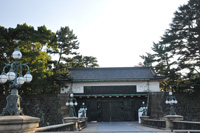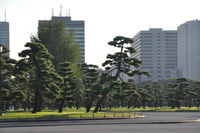 And so I come to my last night in Tokyo and am mostly just grateful to have had the opportunity to see some of this great country and to have had the time to experience a number of its facets. My time in Tokyo has been about twice what I had planned because I felt that I would be missing out if I didn't have some time to spend in the city.
And so I come to my last night in Tokyo and am mostly just grateful to have had the opportunity to see some of this great country and to have had the time to experience a number of its facets. My time in Tokyo has been about twice what I had planned because I felt that I would be missing out if I didn't have some time to spend in the city.
I've already commented some on Asakusa, but I've spent the past three days in Shinjuku, Central Tokyo, and Ueno respectively. Shinjuku makes Times Square look small. Central Tokyo is ruled by order and is cleaner than the rest of the city, if that is even possible. Ueno is a smaller part of Tokyo but home to some national art galleries and the University of Tokyo. It wasn't a bad place to spend a rainy day with the canopy of trees between each of the galleries.
The rain is from the second typhoon to cross Japan in the past week. This one is hitting us head on, but appears to be lacking wind or any kind of storms. Should be nice for the flight home tomorrow. Let me revise that: Wow, it was a really windy night.
 My original intention in basically skipping Tokyo was that I really didn't want to be hemmed in by crowds. I can have that experience in New York or Toronto. But even with so many people, everything is so orderly (trains scheduled to the second) and people so friendly (bowing over the simplest matter). And no one in Tokyo hardly so much as brushes up again one another, even at the busiest intersection. When that many people are carrying umbrellas it's a problem though. The crowds, whether part of them or just watching them, were a highlight.
My original intention in basically skipping Tokyo was that I really didn't want to be hemmed in by crowds. I can have that experience in New York or Toronto. But even with so many people, everything is so orderly (trains scheduled to the second) and people so friendly (bowing over the simplest matter). And no one in Tokyo hardly so much as brushes up again one another, even at the busiest intersection. When that many people are carrying umbrellas it's a problem though. The crowds, whether part of them or just watching them, were a highlight.
I would have missed out on some pretty spectacular experiences if I didn't come back early from Mitake. There is a vibrancy to Tokyo that I'm glad I experienced. It sounds like a cliche, but there is a pulse to the city, and one which feels a bit more unified. It's not the uniforms, or the similarities of dress, or the orderliness, but a sense of common purpose and pride. In all my time here I saw one Japanese flag, but it feels to me that there is a drive to be and look the best as a country.
One noteworthy way the church talks about its own authority is found in the Dogmatic Constitution on the Church (Lumen Gentium), particularly in the third chapter where it acknowledges that the hierarchical nature of the church is rooted in Christ's particular commissioning of the apostles. In a letter I wrote to Joan Chittester in college about this part of our doctrine I asked her to comment on the scriptural evidence. Her response was that even though the gospels talk about the men who were at the Last Supper we should not conclude either that women were not part of that action or that there weren't other ways in which they receive a similar commissioning. Oddly, there was a chalk drawing of the Last Supper at a restaurant in Yonago where women were presented, only as cooking and washing the dishes. I wouldn't have expected to see that image here.
 Church law enshrines the values of community and subsidiarity; yet even after recommendations to the contrary the formulation of the code placed intermediate needs ahead of local churches. The Code acknowledges the richness of conciliar teaching but emphasizes the hierarchical nature of the church (CCC, p. 314). One interesting development is the presentation of authority as rooted in service, vs power as reflected in the old code (CCC, p. 260). The new code is characterized by service to the people of God, rooted in LG and more so in the OT understanding of a people called by God, therefore emphasizing the unity and social nature of the church (CCC, p. 117).
Church law enshrines the values of community and subsidiarity; yet even after recommendations to the contrary the formulation of the code placed intermediate needs ahead of local churches. The Code acknowledges the richness of conciliar teaching but emphasizes the hierarchical nature of the church (CCC, p. 314). One interesting development is the presentation of authority as rooted in service, vs power as reflected in the old code (CCC, p. 260). The new code is characterized by service to the people of God, rooted in LG and more so in the OT understanding of a people called by God, therefore emphasizing the unity and social nature of the church (CCC, p. 117).
A contemporary assessment of the way the church exercises authority suggests the employment of a default ecclesiology which relies on dogmatic responses, an image of the church as unchangeable, and belief in an ahistorical divinely-willed institution. In this view the church is seen as God's household. Thus apostolic succession, in addition to being part of the origins of the church, has lent itself to a more triumphant self-understanding (Cardman, GAFCC). The church's focus on authenticity in its teaching is a logical attempt to preserve the understanding of Jesus and his message as they really were. The impulse to refute heresy is understandable. Believers want to be known as they really are.
But how does the church "carry itself"? According to Rahner, "Authority functions as a substitute in a tutelary role (1968)."
Well, I'm prepared to offer some observations on authority from my life as a pastor and the role of the church in academia, but it's getting to be time to wind down for the time being. I won't be adding any more pics to this site. These are not necessarily the best, but they are the most representative of the 1,650 or so that I have at this point. I've probably discarded at least another 2,000. That's the benefit of digital photography. I do plan to add captions eventually.
This may be wishful thinking, but I hope to begin elaborating on what I've written here as early as this week. I had done some research before I left and there are still stacks of books on my desk in Kersey waiting to be picked up again. I'm confident that I've made a good start to a framework for writing a new ministerial platform which, as I now see it, was the effective purpose of the trip. I welcome your thoughts on my jottings in any form you wish to offer them.
